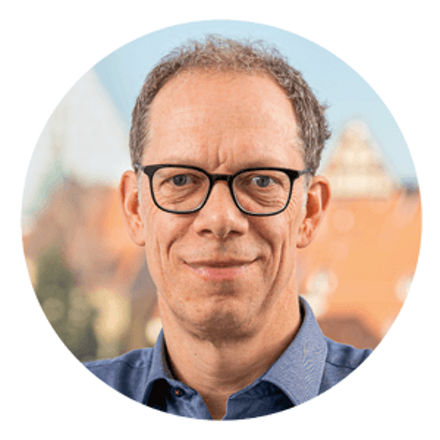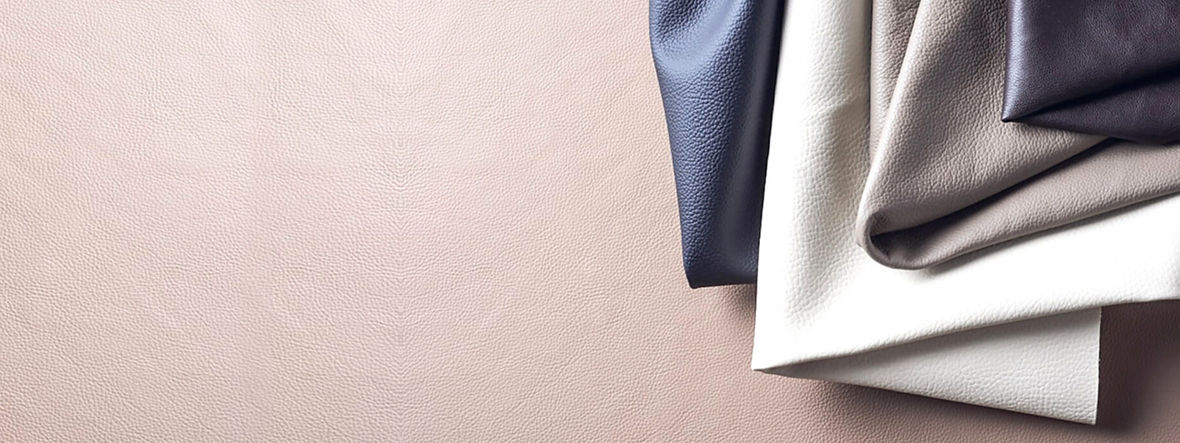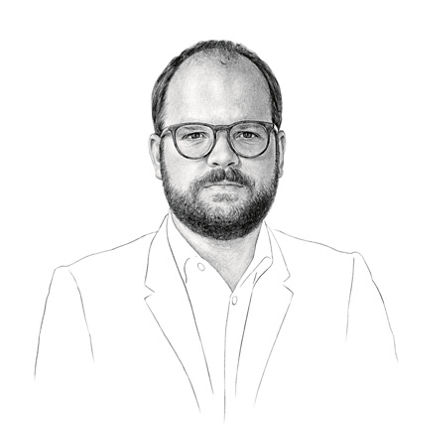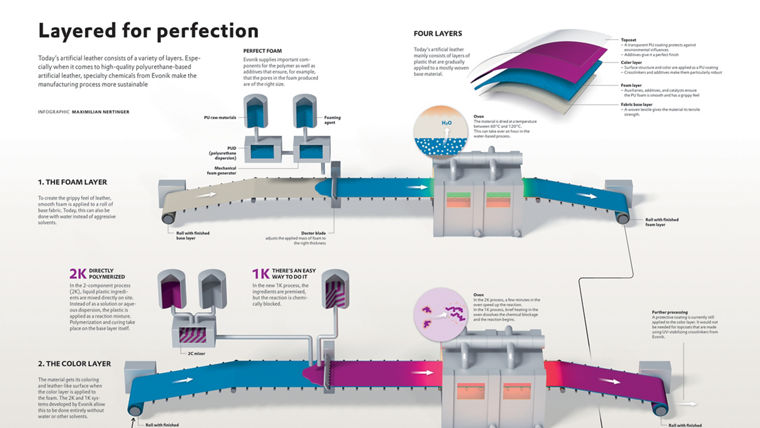Tesla swears by it, and so do Stella and PETA. What is it? Artificial leather. Tesla, the US electric automaker, sells all of its Model 3 cars with seat covers made of imitation leather. The fashion designer Stella McCartney has always refused to use genuine leather for her handbags and shoes. And the animal protection organization PETA publishes artificial leather style guides for a growing throng of fashionistas who want to save cows’ lives. “A killer look without any killing” is its slogan.
“Vegan leather” is a current trend. The concept itself is a perfect fit for our age. More and more consumers are concerned about climate change, animal welfare, and the environment. Man-made leather offers many advantages in this area. It doesn’t victimize living creatures or require arable land for growing animal feed. It’s less of a burden on the climate and consumers’ consciences.
There’s no need to worry about compromises regarding quality and workmanship. Gone are the days when imitation leather felt like plastic and quickly became brittle and cracked. Today even experts find it hard to tell the difference between the imitation and the original. In some applications, artificial leather is even superior to real leather. This has become possible thanks to improved chemical ingredients and new production processes. Evonik is an expert in both. Today its products can be found in just about every layer of modern artificial leathers. The Essen-based specialty chemicals company now plans to set new benchmarks for the sustainability of the production processes as well.
Flexible and resilient
One of the incubators of innovative products for artificial leather is located in the town of Herne in the heart of the Ruhr region. This is where Evonik produces crosslinkers—substances that give the layers of modern polymers their longevity as well as several other special properties. From its base in Herne, Evonik has exported this technology and its products throughout the world. The production complex in western Germany is exactly duplicated by the one in Shanghai, China. Additional production plants are located in Antwerp (Belgium) and Mobile, Alabama (USA). Crosslinkers of the Evonik brand VESTANAT® make it possible to produce particularly durable coatings and polymer films. They link the long polymer molecules into a robust network that resists intense mechanical and chemical strains. This ensures the durability of vehicle structures, industrial flooring, and wind turbines, for example. In artificial leather, by contrast, crosslinkers extend the molecular chains to create a flexible yet resilient material.

Cutting into artificial leather reveals how this works. The material is multilayered, consisting of several plies, each of which performs its own task. A textile base guarantees stability, a foam layer ensures a soft texture, and a topcoat provides surface structure and color. In most cases it is covered by a clear layer that protects the material from UV light and other stressors. “Actually, in most cases there are still a few more layers that work together to create the desired effects,“ says Dr. Michael Meyer, a biologist and process engineer who heads the FILK Freiberg Institute, a successor of the research institute for leather and artificial leather technology in Freiberg, Saxony. The institute’s origins can be traced back to a tannery school in the 19th century, when leather production and mining flourished in this region.

»In high-quality artificial leathers polyurethane dominates«
MICHAEL MEYER HEAD OF THE FILK FREIBERG INSTITUTE
China dominates the market
During the GDR era, the institute also specialized in artificial leather. Nowadays Meyer and FILK work for both the leather and the artificial leather sectors—and everything in between. “It’s no longer possible to make an absolutely clear distinction between them,” says Meyer. He points out that paints and plastic coatings have long been used in the processing of leather made of animal skins as well. “The automobile industry and its demand for surface designs that can be reproduced any number of times gave this change its biggest boost,” he explains. Today the institute also focuses on biotechnology. That’s because researchers are increasingly experimenting with biological raw materials in order to produce artificial leather.
But the overall situation is still well-defined. “The global market for artificial leather is very clearly dominated by traditional products based on PVC or polyurethane,” says Martin Lei, an Evonik manager who heads the marketing of crosslinkers in the Asia-Pacific region from his office in Shanghai. In the sector, there are practically no alternatives to China. Over 80 percent of the world’s supply of artificial leather comes from China. Most recently that amounted to about three million tons per year. China is followed, at some distance, by other Asian countries such as Vietnam and Thailand. “Even in the case of some artificial leathers that are marketed as ‘Made in Italy,’ for example, only the final finishing steps were actually carried out in Europe,” says Lei. “The basic material comes from Asia.” The amounts of artificial leather made from PVC and from polyurethane (PU) worldwide are roughly equal. However, when it comes to quality PU is very clearly superior. “PVC is cheap to produce,“ says FILK director Meyer, “but in high-quality artificial leathers polyurethane dominates.” Polyurethane is more versatile, usually more pleasant to the touch, longer-lasting, and superior even to genuine leather in some respects. For example, PU artificial leather can be washed in a washing machine.

Less problematic alternatives
Its production is also becoming increasingly sustainable. Today artificial leathers based on PU can largely be produced without the use of harmful solvents. This was not always the case. For a long time the use of dimethylformamide, or DMF for short, was a particular defect of PU artificial leather production. DMF is used to transfer the plastic in dissolved form onto the textile web. During the deposition and drying processes, the solvent evaporates and the PU layer remains. Large amounts of water must be used to wash out the DMF residues. Because DMF is harmful to workers and the environment, manufacturers are trying to eliminate it. Last year the EU once again tightened the directives for the sale of products that contain even minimal amounts of DMF. The Chinese government is also pressuring industries to reduce the amount of DMF and other solvents they use. And more than 170 fashion companies have joined forces to completely ban chemicals such as DMF from their supply chains.

The industry has been offering less problematic alternatives for a long time. For example, the foam layer, the topcoat, and the protective coating of polyurethane can be applied as a watery dispersion—a mixture consisting almost exclusively of water and PU microparticles. As a result, only water rather than organic solvent evaporates in the drying oven. According to market forecasts, the use of the dispersion process will increase about sixfold between 2021 and 2027 in China’s PU artificial leather production industry alone. Evonik is promoting this trend by offering products for this process.
However, in the past it has been difficult to produce a foam layer based on aqueous PU dispersions at the desired level of quality. There was a lack of foam stabilizers specially optimized for this application. Developers from the Evonik Comfort & Insulation business line precisely focused their research on this area in order to fill this technological gap with their foam additives of the ORTEGOL® P brand. These foam additives also improve the energy, raw material, and emissions balance of artificial leather production and are 100% based on plant-based raw materials.

LEATHER MADE OF MUSHROOMS, CORK, AND CACTI
Substitutes derived from raw materials also require chemistry Artificial leather is also part of the trend toward “organic” materials. Scientists are researching many innovative leather substitutes with a biological basis. For example, Evonik is working on a mixed material that not only resembles leather but also can be processed in completely new ways. In 2019, the company therefore invested in the US startup Modern Meadow, which produces collagen with the help of yeast cells. This structural protein is a major component of skin and connective tissue. The startup company, which is based in Nutley, New Jersey, aims to use collagen together with biologically based polymers to produce a material that is similar to leather. Michael Meyer, the expert at the FILK Freiberg Institute in Saxony, calls biomaterials of this kind “trend substitutes.” Today there are artificial leathers based on apple peel, pineapple leaves, mushrooms, cork, and cacti. However, even these biologically based materials can become usable alternatives only with the help of chemical products and coating technology. By now some of them have matured to the point of being very acceptable alternatives. “All the same, they are not purely natural products,” says Meyer, the leather expert.
UV protection and top coat in one
Meanwhile, Evonik is working on other alternative technologies at the Marl Chemical Park. “It also works without any water at all,” says Denis Pukrop from the Crosslinkers business line. He has helped to develop a process in which the PU topcoat of modern artificial leathers can be applied from reactive systems in a simple, efficient, and environmentally friendly process. This process, which is known as 2K, is already common practice in some industries. For example, it’s used by metalworking companies for processes such as coating sheet metal to make it weather-resistant.

“2K” stands for “two-component.” The components of a chemical reaction for long polymer molecules are mixed in a liquid state and applied in order to start the polymerization on the base material. “People are familiar with this process in the two-component glues they can buy in DIY stores,“ says Pukrop. “As soon as the two components are stirred together, polymerization begins and the mixture hardens.” For polyurethane, the process uses polyols—alcohols with three or more hydroxyl groups—which harden to form a network of long-chain polyurethane molecules when they are mixed with the right crosslinkers.
In the 2K process, a polymer layer forms on the carrier material within minutes without the need to subsequently remove any water or solvents. “In order to accelerate the process, you need a much shorter time in the oven and a correspondingly low energy input,” says Pukrop. A key product for this process is VESTANAT® IPDI—cycloaliphatic isophorone diisocyanate, in chemical terms—which improves the drying and hardening of such coatings. That’s why it also plays an important role in dispersion processes. Incidentally, it also makes the coating light-fast and weather-resistant. “As a result, it’s possible to directly incorporate the UV protection into the topcoat and dispense with an additional protective coating,” Pukrop explains. There’s also another advantage: Evonik uses renewable raw materials to manufacture this product—as well as all of its other isophorone products from Herne. In the life cycle assessment of the example cited above, 75 percent of the product consists of renewable carbon.

Further simplification is possible
The 2K process that Evonik has optimized especially for artificial leather production offers advantages in terms of efficiency and sustainability. However, it does have a catch. Its use is well established in the coatings industry in particular, but for the manufacturers of artificial leather it’s a new challenge, and because of the components’ reactivity and other factors it’s not very easy to manage. Because the reaction begins automatically, good timing is important. Once the two components have been mixed together, the bonding process can no longer be halted. “A product change results in residues, and that results in waste and costs,” Pukrop explains.

As a result, the expert has improved a further process for the production of artificial leather. It’s called a 1K process because it uses only one component. In this process, the same components as those used for the 2K process have already been mixed together previously. They can be transported together and handled without any problems. The trick here is the fact that the polymer reaction has been chemically blocked. The blockage is resolved only after the mixture has been briefly heated to a temperature between 130 and 150°C, allowing the polymerization to begin. Evonik is already offering blocked crosslinkers of this kind for other industries, such as manufacturers of powdered coatings. This recently patented process has been optimized for artificial leather production in order to make especially flexible and stretchable coatings possible. “For the manufacturers, this means they don’t have to learn so much new information about how to manage the process, and they also need to make fewer changes in their production processes,” explains Guido Streukens, who heads the application technology unit for VESTANAT® in Marl. The blocking material simply releases small amounts of alcohol to resolve the blockage.
Today the sector is only beginning to replace solvent-based processes with water-based ones on a large scale. And the 2K process is only being used in a few special applications. However, the advantages of modern 1K technology are adding up: no use of solvents, drastically reduced consumption of water and energy compared to the dispersion processes, and even less production complexity and waste than for the 2K process. Thanks to excellent reasons like these, Tesla, Stella, and PETA may soon be joined by many other fans of vegan leather.



